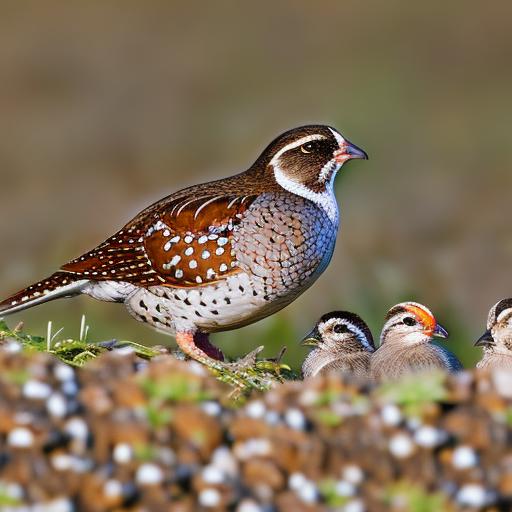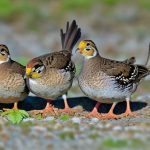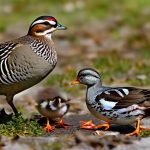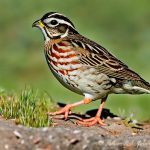Quails are small, ground-dwelling birds that are known for their social behavior and strong family bonds. They are highly social birds and are often found in groups called coveys. Within a covey, there is a complex social structure with dominant and subordinate individuals. The dominant birds, usually the males, will establish a pecking order within the group, with the most dominant bird having access to the best food and mating opportunities. Subordinate birds will often follow the lead of the dominant birds and will work together to forage for food and protect each other from predators.
Quails are also known for their strong family bonds. During the breeding season, a mated pair will work together to build a nest and raise their young. The male will often take on the role of protector, while the female will incubate the eggs and care for the chicks once they hatch. Quail chicks are precocial, meaning they are born with their eyes open and are able to feed themselves shortly after hatching. However, they still rely on their parents for protection and guidance. Understanding the social structure and behavior of quails is important for anyone looking to raise or manage a population of these birds.
Quails are also known for their strong family bonds. During the breeding season, a mated pair will work together to build a nest and raise their young. The male will often take on the role of protector, while the female will incubate the eggs and care for the chicks once they hatch. Quail chicks are precocial, meaning they are born with their eyes open and are able to feed themselves shortly after hatching. However, they still rely on their parents for protection and guidance. Understanding the social structure and behavior of quails is important for anyone looking to raise or manage a population of these birds.
Key Takeaways
- Quail are social birds that form strong pair bonds and live in groups called coveys, with a complex social structure.
- Factors to consider when determining quail population size include available habitat, food sources, and predation risks.
- Quail require a minimum of 1-2 square feet of space per bird in captivity, with access to shelter and nesting areas.
- Feeding and watering considerations for quail include providing a balanced diet, access to grit for digestion, and clean, fresh water at all times.
- Breeding and reproduction considerations for quail include providing suitable nesting areas, monitoring egg production, and ensuring proper incubation conditions.
- Health and disease management for quail involves regular monitoring for signs of illness, providing a clean living environment, and seeking veterinary care when necessary.
- Legal and regulatory considerations for quail ownership may include obtaining permits, following hunting regulations, and adhering to animal welfare laws.
Factors to Consider When Determining Quail Population Size
When determining quail population size, there are several factors that need to be taken into consideration. One of the most important factors is the availability of suitable habitat. Quails require a mix of open grasslands for foraging and dense cover for nesting and protection from predators. Without adequate habitat, quail populations will struggle to survive and reproduce.
Another important factor to consider is food availability. Quails are omnivorous birds and will feed on a variety of seeds, insects, and vegetation. A lack of food can lead to malnutrition and decreased reproductive success in quail populations. Additionally, water availability is crucial for quail survival, especially during hot and dry periods. Access to clean water sources is essential for maintaining healthy quail populations.
Predation is also a significant factor to consider when determining quail population size. Quails are preyed upon by a variety of predators, including hawks, snakes, and mammals. High predation rates can significantly impact quail populations, so it’s important to manage predator populations and provide suitable cover for quails to escape from predators.
Space Requirements for Quail
Quails require a certain amount of space to thrive and reproduce successfully. In general, it’s recommended to provide at least 1-2 acres of suitable habitat per covey of quails. This habitat should include a mix of open grasslands for foraging and dense cover for nesting and protection from predators. Providing adequate space allows quails to establish territories, forage for food, and find suitable nesting sites.
In addition to habitat space, it’s important to consider the space requirements for housing quails in captivity. If you’re raising quails in an aviary or pen, it’s important to provide enough space for the birds to move around freely and engage in natural behaviors such as dust bathing and scratching for food. Overcrowding can lead to stress, aggression, and decreased reproductive success in captive quail populations.
When considering space requirements for quails, it’s also important to take into account the social structure of these birds. Quails are highly social animals and prefer to live in groups called coveys. Providing enough space for multiple coveys to establish territories and interact with each other is important for maintaining healthy quail populations.
Feeding and Watering Considerations for Quail
Feeding and watering considerations are crucial for maintaining healthy quail populations. Quails are omnivorous birds that feed on a variety of seeds, insects, and vegetation. In the wild, they will forage for food in open grasslands and agricultural fields. When raising quails in captivity, it’s important to provide a balanced diet that includes commercial game bird feed as well as access to fresh greens, insects, and grit.
In addition to providing a balanced diet, it’s important to ensure that quails have access to clean water at all times. Water is essential for quail survival, especially during hot and dry periods. Providing multiple water sources throughout their habitat or enclosure can help ensure that quails have access to water at all times.
When feeding and watering quails in captivity, it’s important to monitor their food and water intake to ensure that they are getting enough nutrients and hydration. Adjusting feeding and watering schedules based on environmental conditions and the reproductive cycle can help support healthy quail populations.
Breeding and Reproduction Considerations
Breeding and reproduction considerations are important for maintaining healthy quail populations. Quails typically breed in the spring and summer months when food is abundant and environmental conditions are favorable. Mated pairs will work together to build a nest on the ground or in dense cover, where the female will lay a clutch of eggs.
Once the eggs are laid, the female will incubate them for about 21 days before they hatch. During this time, it’s important to provide the female with a quiet and secure nesting area to minimize disturbances that could lead to nest abandonment or egg mortality.
After the eggs hatch, the chicks will rely on their parents for protection and guidance. Providing suitable habitat with plenty of cover and access to food and water is crucial for supporting healthy chick survival.
In captivity, breeding and reproduction considerations include providing suitable nesting materials and boxes for mated pairs to build nests, as well as monitoring egg production and chick survival rates. Managing breeding pairs to prevent inbreeding and genetic issues is also important for maintaining healthy captive quail populations.
Health and Disease Management for Quail

Health and disease management are crucial for maintaining healthy quail populations. Quails are susceptible to a variety of diseases and parasites that can impact their overall health and reproductive success.
One of the most common health issues in quails is coccidiosis, a parasitic disease that affects the intestinal tract. Providing clean bedding materials, regular cleaning of enclosures, and monitoring fecal samples can help prevent coccidiosis outbreaks in captive quail populations.
Another common health issue in quails is respiratory infections, which can be caused by poor ventilation or exposure to drafts. Providing well-ventilated housing with proper temperature control can help prevent respiratory issues in captive quail populations.
In addition to disease management, it’s important to monitor quail populations for signs of stress or aggression, which can indicate overcrowding or social issues within the group. Providing enough space, suitable habitat, and enrichment activities can help support overall health and well-being in captive quail populations.
Legal and Regulatory Considerations for Quail Ownership
When owning or managing quail populations, it’s important to be aware of legal and regulatory considerations that may apply to your specific location. In many areas, there are regulations regarding the ownership, breeding, hunting, and release of quails.
For example, some regions may require permits or licenses for owning or breeding quails in captivity. Additionally, there may be specific regulations regarding hunting seasons, bag limits, and hunting methods for wild quail populations.
If you’re considering releasing captive-bred quails into the wild as part of a conservation or reintroduction program, it’s important to be aware of any regulations regarding the release of non-native species or genetically modified organisms.
Being aware of legal and regulatory considerations can help ensure that you are in compliance with local laws and regulations while owning or managing quail populations. It’s important to research and understand the specific requirements that may apply to your situation in order to maintain legal compliance while working with quails.
If you’re wondering how many quail you should keep, it’s important to consider the specific needs and behaviors of these birds. Understanding their breeding habits, egg production, and living conditions is crucial for successful quail keeping. For more insights into egg production, you might find this article on how many eggs geese lay helpful. It’s always beneficial to gather information from various poultry sources to ensure the well-being of your quail.
FAQs
How many quail should I keep in a flock?
It is recommended to keep at least 3-4 quail in a flock to ensure social interaction and to prevent loneliness and stress.
What is the maximum number of quail I can keep in a flock?
The maximum number of quail that can be kept in a flock depends on the size of the enclosure and the availability of resources such as food and water. It is important to provide adequate space and resources for each quail to thrive.
What are the benefits of keeping multiple quail in a flock?
Keeping multiple quail in a flock allows for social interaction, reduces stress and loneliness, and can improve overall well-being. It also mimics their natural behavior in the wild.
What are the potential drawbacks of keeping too many quail in a flock?
Keeping too many quail in a flock can lead to overcrowding, increased competition for resources, and potential aggression among the birds. It can also lead to unsanitary conditions if the enclosure is not properly maintained.
How do I determine the ideal number of quail for my specific situation?
Consider factors such as the size of the enclosure, the availability of resources, and your ability to provide proper care and maintenance. It is important to ensure that each quail has enough space and resources to thrive.
Meet Walter, the feathered-friend fanatic of Florida! Nestled in the sunshine state, Walter struts through life with his feathered companions, clucking his way to happiness. With a coop that’s fancier than a five-star hotel, he’s the Don Juan of the chicken world. When he’s not teaching his hens to do the cha-cha, you’ll find him in a heated debate with his prized rooster, Sir Clucks-a-Lot. Walter’s poultry passion is no yolk; he’s the sunny-side-up guy you never knew you needed in your flock of friends!







